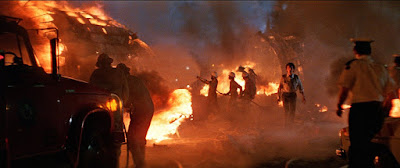It seems inconceivable to me that I'd never seen The Revenge of Frankenstein (1958, directed by Terence Fisher) before this week. I spent a lot of my youth watching Hammer films, particularly the Dracula series, yet this one somehow escaped me and I'm poorer for it. I know why I missed it. It's because a short passage in Carlos Clarens's An Illustrated History of the Horror Movie dismissed the film out of hand. Clarens noted that it was released on a double bill with Curse of the Demon, suggesting that Curse towers over The Revenge of Frankenstein, "which, in a wink, it eclipsed." It's hard to recover from that kind of dismissal. I think it's been in the back of my mind whenever The Revenge of Frankenstein has been presented to me. So I ignored the film for years. This is totally unfair to the film. I mean, Curse of the Demon is a masterpiece and you can't really compare any less than masterpiece to it and hope to have a fair comparison, but there's nothing inherently bad about The Revenge of Frankenstein. It's a handsome film. In its way, it might be the best of the Hammer Frankensteins, which is admittedly faint praise.
Monday, October 16, 2017
Dr. Frankenstein, I Presume
Posted by
Vulnavia Morbius
at
12:55 PM
0
comments
![]()
Labels: Hammer Studios, horror, horror movies, October Challenge, October Challenge 2017, The Revenge of Frankenstein
Friday, October 06, 2017
A Kaiju Haunting
Godzilla, Mothra, and King Ghidorah: Giant Monsters All-Out Attack (2001, directed by Shûsuke Kaneko) has a novel big idea. It postulates that the reason Godzilla favors attacking Japan over all other nations is because he is animated not just by the atom bomb, but also by the souls of all the pan-Asian dead of World War II. Japan, the movie further postulates, needs a reminder of its responsibility for that catastrophe. This is the kaiju equivalent of the J-horror films that are this movie's contemporaries, in which the giant monsters act as conduits for ghosts. Godzilla plays the role that the video tape played in The Ring, and that the internet played in Pulse. This is one of the rare late Godzilla films that casts Godzilla as a villain, rather than as a defender of Japan, a fact reflected in the design of its star: he has milky white eyes without pupil or iris, like he's possessed. This is one of the most lethal Godzillas, one possessed of an implacable malice rather than the indifference of a force of nature.
Posted by
Vulnavia Morbius
at
7:08 PM
0
comments
![]()
Labels: Godzilla, Godzilla Mothra and King Ghidora: Giant Monsters All-Out Attack, Japanese Cinema, kaiju
Sunday, October 01, 2017
Any Landing You Can Walk Away From
It's October again. That means it's time for the October Horror Movie Challenge, in which I try to watch 31 horror movies during the month, including at least 16 that are new to me. Given that I've been away from blogging for a while, this also means I'm going to try to write about all of them. Wish me luck.
The Survivor (1981, directed by David Hemmings) is a film I remember seeing on HBO way back in the early 1980s. While I say that I remember seeing it, I only remember seeing it because the plane crash that opens the film is spectacular and legitimately terrifying. It sticks in the memory. The rest? I vaguely remembered some of the film's ghostly shenanigans (the dude lured onto the train tracks for instance), and I remembered Jenny Agutter, but only in fragments. It turns out that there's a reason for that. It's a slow, meandering film that has none of the pulp vitality you would expect from a film based on a James Herbert novel. And yet, here it is.
Posted by
Vulnavia Morbius
at
10:33 AM
0
comments
![]()
Labels: Australian cinema, horror movies, October Challenge, October Challenge 2017, The Survivor














